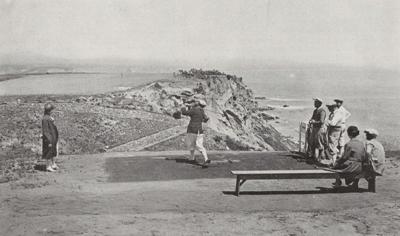By Carlos N. Olvera
Dana Point’s first planned golf course was attempted in 1925 and was to be located at the end of Amber Lantern, atop the sweeping bluffs made famous by Richard Henry Dana. The architect was John Duncan Dunn.
With your face to the ocean, a drive east faced a major challenge—a canyon to cross. Most of the canyon has since been filled. It reached from the beach to Pacific Coast Highway which was only a dirt county road at that time. It is currently bounded by Amber Lantern and Violet Lantern. A rock lined trail, built by Ed Seaman in 1924, lined both sides of the canyon to the beach below and its remnants are still visible today but not accessible.
Duncan also was the architect for the Santa Ana Country Club in 1929 and the Catalina Island Golf Club in Avalon in 1895.
The second attempt at placing a course in Dana Point came during the 1927 S. H. Woodruff development. Dr. Alister Mackenzie, along with Robert Hunter, visited with Woodruff in March, 1927 looking at a site near where Dana Hills High School is today.
Important to this project was the need for water, and Woodruff was proud to show off his newly formed Dana Point Water Company and their newly placed water tank. That tank is atop a hill just off Stonehill and Golden Lantern in the Waterford Pointe development. That same week Mackenzie visited the California Monterey peninsula to plan Cyprus Point. That 18-hole championship course now boasts the most dramatic three holes that play along the ocean including the par-3, 231-yard 16th hole.
The tank, now referred to as the Dana Point Reservoir, is located at the highest point in Dana Point at 346 feet above sea level and holds two million gallons. It was reconstructed in 1973 by the Capistrano Beach Water District and is managed today by South Coast Water District.
Woodruff said at the time “year-round golf of the Southland is bringing millions of dollars each year to Southern California. There are said to be 65 evergreen golf courses in Southern California following the contour or rolling lands, making golf most delightful summer and winter. There are courses of every class and character, designed and constructed by some of the foremost golf architects In the United States, so in planning our course at Dana Point, we are very carefully studying the needs and requirements or our situation.”
Included in Woodruff’s design were plans for the Dana Point Golf Clubhouse, by architect Charles A. Hill, located just below the water reservoir. The course was laid out going northwest where the Dana Hills High school is located.
Dana Point finally did get its golf course with Monarch Beach Golf Links, which first opened in 1983. Designed by master architect Robert Trent Jones, it is one of the few oceanfront courses in California. The championship course is a par 70. While the course is on the inland side of the Pacific Coast Highway, the par-4, 3rd hole lies adjacent to the sandy beach.
Carlos N. Olvera is past president of the Dana Point Historical Society, current Vice Chair of the OC Historical Commission and a Dana Point Councilman.
In an effort to provide our readers with a wide variety of opinions from our community, the DP Times provides Guest Opinion opportunities in which selected columnists’ opinions are shared. The opinions expressed in these columns are entirely those of the columnist alone and do not reflect those of the DP Times or Picket Fence Media. If you would like to respond to this column, please email us at editor@danapointtimes.com.


